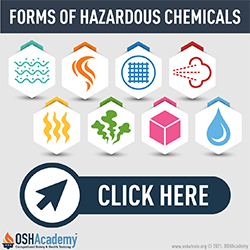Forms of Hazardous Chemicals
The standard's definition of "chemical" is much broader than that commonly used. According to the HCS, chemicals that apply may exist in one of many forms:
Dusts - are finely divided particles. Example - wood dust.
Fumes - are even smaller particles usually formed when solid metal is heated and vaporized, and then condenses as tiny particles.
Fibers - are similar to dusts but are of an elongated shape. Examples - asbestos and fiberglass.
Mists and Fogs - are small liquid droplets that have been sprayed into the atmosphere forming mists or fog.
Vapors - are gases formed when liquid evaporates.
Gases - are substances that are normally airborne at room temperature. A vapor is the gaseous phase of a substance which is normally a liquid or solid at room temperature.
Solids - such as metal, treated wood, plastic.
Liquids - the most common form in the workplace.
Knowledge Check Choose the best answer for the question.
2-2. Which form of hazardous chemical is created when solid metal is heated and vaporized?
You forgot to answer the question!

